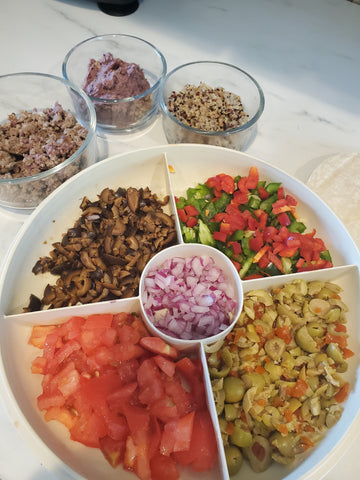Tacos For the Metabolic Win!

Ingredients:
½ cup green olives
½ cup walnuts
½ cup hummus
4 Romaine leaves, washed
Optional toppings:
salsa
onions
black beans
Tomatoes
Olives
Peppers
sprouts
Directions:
Chop the olives and walnuts together until they are quite small and set aside.
Spread a layer of hummus onto each of the romaine leaves.
Add a spoonful of the olive/walnut mix onto each leaf.
Then I put a spoonful of black beans, a few pieces of lettuce or spinach, and a dollop of salsa and any additional toppings.
Folded, they can be stored easily and transported if needed, or eaten immediately.
Nutrition:
I swapped meat for beans and hummus, olives, and walnuts for fat and fiber. In the base mix alone (½ cup olives, ½ cup walnuts) there is 4.5g of fiber in one taco.
One Health Condition this recipe supports:
While there are multiple benefits to this recipe, I specifically focused on changes that would be in alignment with someone with metabolic syndrome. In the substitution of animal protein in traditional ground beef containing tacos and the corn shells to walnut, olive, and humus, and lettuce wraps, the focus is put on fiber and fat. Data shows that switching from carbs to fats and adding fats in general, particularly poly and monounsaturated fats can lower triglycerides.1 Fasting insulin levels are shown to be reduced by adding polyunsaturated fats, instead of saturated fats from ground beef and fried shells.1 Fiber comes from the beans, walnuts, and olives, which is an under consumed nutrient in the US population.2 Fiber is shown to have an association with lowered risk of metabolic syndrome.3
Additional Health Benefits:
- Other health benefits include the fact that they are easily adaptable to multiple needs. I usually make multiple proteins to go with them like ground beef, quinoa, homemade refried beans, as well as the olive/walnut mixture, and a divided dish to contain multiple vegetable toppings. This way, it makes feeding a multi-varied dietary needs family a snap. It is easy then to choose the option of a traditional corn tortilla, lettuce wrap, cassava shell, or simply a no shell taco salad.
- Animal protein is switched for plant proteins, making it acceptable to vegans and vegetarians as well as increasing plant phytochemicals in omnivorous eaters.
- Focus is put on fiber through the nuts, olives and beans, which is an underconsumed nutrient.2
- The recipe was created with fats in mind coming from walnuts, and olives and saturated fats are removed, supportive for proper dietary fat balance.
- Swapping the corn shells for cassava or romaine leaves makes it a workable food for those with low carb diets.
- With the focus being on plant proteins instead of the beef, bean, cheese wrapped in a shell traditional taco, we reduce consumption of saturated fats, known to be a cardiovascular risk4; and we open up the possibility of more vitamins, minerals, and phytochemicals coming from the multiple veggie toppings.
1 Clifton P. Metabolic Syndrome-Role of Dietary Fat Type and Quantity. Nutrients. 2019;11(7):1438. Published 2019 Jun 26. doi:10.3390/nu11071438
2 Redmond, M. Presented: Nutrient Density Introduction. Presented as part of Masters of Clinical Nutrition program at SCNM, Viewed July 8, 2021: Canvas online.
3 Chen JP, Chen GC, Wang XP, Qin L, Bai Y. Dietary Fiber and Metabolic Syndrome: A Meta-Analysis and Review of Related Mechanisms. Nutrients. 2017;10(1):24. Published 2017 Dec 26. doi:10.3390/nu10010024
4 Siri-Tarino PW, Sun Q, Hu FB, Krauss RM. Saturated fat, carbohydrate, and cardiovascular disease. Am J Clin Nutr. 2010;91(3):502-509. doi:10.3945/ajcn.2008.26285

